The affect of technology on athletes’ “on-field” capabilities has been the subject of controversy recently. We saw banned shoes in the NBA, the concept of “challenging” calls via rewinding film in the MLB, and new football helmets so strong that they tackle injuries. With all the buzz of technology’s affect on field, is influence off the field is often neglected.
This influence is seen within football, as America’s most popular sport has experienced a recent dramatic decrease in attendance. This is due to a host of reasons but the most prominent: relentlessly evolving technology. With advancements in television such as 3D, high definition, and instant replay, most fans would simply prefer view the game at home. In fact, 2011 showed the lowest average attendance since 1998 and a poll taken in 2011 revealed that only 29% would rather watch a game in person compared to 41% in 1998 – a statistic that illustrates technology’s increasing momentum.
One effect of this decrease in attendance is something called “blackouts,” a policy that prevents a home game from being aired locally unless it is sold out 72 hours prior to kickoff in order to entice local attendance. As you may imagine, blackouts are a quick way for teams to lose money.
In addition to the pleasurable viewing experience that awaits fans at home, most don’t want to deal with overpriced food and tickets, hunting for parking, and waiting in long smelly lines to use the restroom. NFL commissioner Roger Goodell is aware of all this. “We have made the point repeatedly that the experience at home is outstanding,” he said at an owner’s meeting. “And we have to compete with that in some fashion by making sure we create the same kind of environment in our stadiums and use the same kind of technology.” It will be interesting to see if stadiums implement the technology that viewers enjoy at home; fighting fire with fire.
